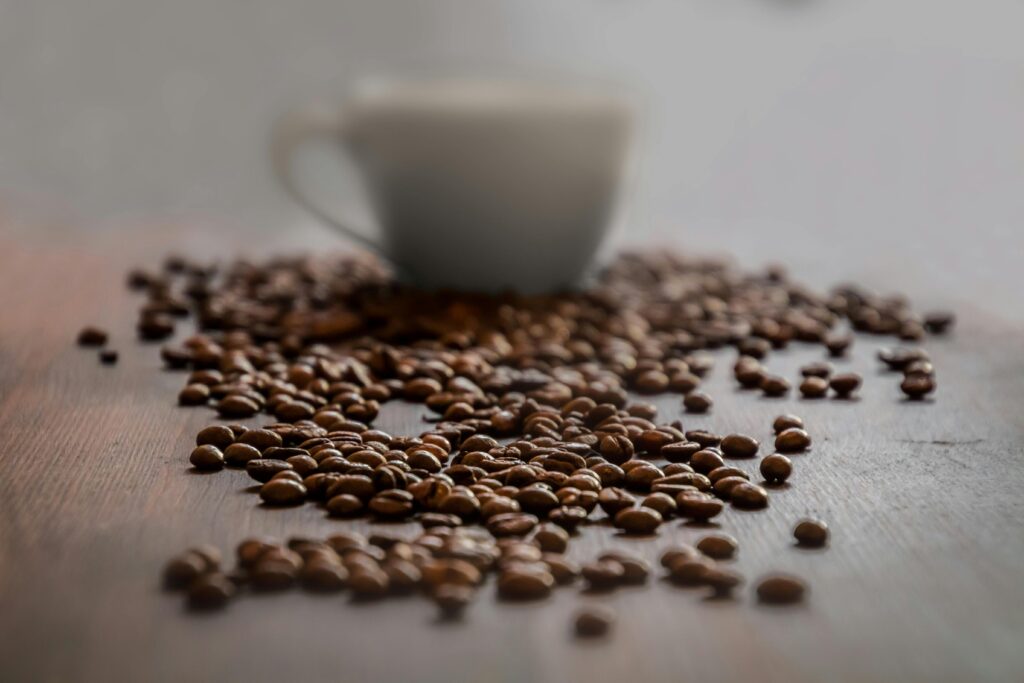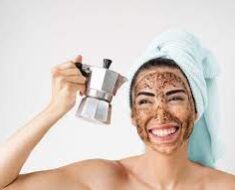Are you looking for a natural way to rejuvenate your skin?
Have you heard about the wonders of coffee bean extract for skin care? In this article, we delve into the benefits and secrets of this powerful ingredient.
Coffee bean extract is a skincare powerhouse, packed with antioxidants that combat free radicals and promote cell regeneration. Its caffeine content stimulates blood flow, reducing puffiness and dark circles.
Moreover, it enhances collagen production, leading to firmer, more youthful-looking skin.
Curious to unlock the full potential of coffee bean extract for your skin?
Join us as we explore expert insights, tips, and recommended products for harnessing this natural beauty elixir. Discover the transformative effects and embark on a journey towards radiant, glowing skin today!
Here coffee bad for skin.
Coffee bean extract for skin
Coffee bean extraction is the process of obtaining soluble compounds, flavors, and aromas from coffee beans to create beverages like coffee.
There are two primary methods of extraction: brewing and chemical extraction.

Brewing involves hot water passing through ground coffee beans, extracting oils, acids, sugars, and other compounds. This method is used in traditional coffee-making techniques like drip brewing, French press, espresso, and pour-over.
Chemical extraction uses solvents like water, organic solvents, or supercritical carbon dioxide to extract specific compounds from coffee beans.
This method is common in producing decaffeinated coffee, where caffeine is selectively extracted while preserving flavor compounds.
Both methods aim to achieve a balanced extraction, extracting desirable flavors while avoiding bitterness or off-flavors.
Factors like grind size, water temperature, pressure, and extraction time play crucial roles in determining the quality and characteristics of the extracted coffee.
What is extraction of coffee bean?
Coffee bean extraction is the process of obtaining soluble compounds, flavors, and aromas from coffee beans to create beverages like coffee.
There are two primary methods of extraction: brewing and chemical extraction.
Brewing involves hot water passing through ground coffee beans, extracting oils, acids, sugars, and other compounds.
Here, is iced coffee bad for your skin?
This method is used in traditional coffee-making techniques like drip brewing, French press, espresso, and pour-over.
Chemical extraction uses solvents like water, organic solvents, or supercritical carbon dioxide to extract specific compounds from coffee beans.
This method is common in producing decaffeinated coffee, where caffeine is selectively extracted while preserving flavor compounds.
Both methods aim to achieve a balanced extraction, extracting desirable flavors while avoiding bitterness or off-flavors. Factors like grind size, water temperature, pressure, and extraction time play crucial roles in determining the quality and characteristics of the extracted coffee.
How to extract coffee bean?
To extract coffee beans, follow these steps:
- Selection and Sorting: Choose high-quality coffee beans and sort them to remove any defects or foreign objects.
- Roasting: Roast the beans to develop flavor compounds. Different roast levels (light, medium, dark) yield distinct flavor profiles.
- Grinding: Grind the roasted beans to the desired consistency based on the brewing method (coarse for French press, medium for drip coffee, fine for espresso).
- Brewing: Use hot water to extract flavors from the ground coffee. Common brewing methods include drip brewing, French press, espresso machines, and pour-over techniques.
- Extraction Time: Adjust the extraction time based on the brewing method and grind size. Longer extraction times can result in stronger flavors but may lead to bitterness.
- Filtering: Use filters or sieves to separate the brewed coffee from the spent grounds, ensuring a smooth, sediment-free beverage.
- Enjoy: Serve the freshly extracted coffee and savor its aroma and flavor notes. Adjust variables like grind size, water temperature, and coffee-to-water ratio to customize your brew.
7 methods to extract coffee bean
1. Drip Brewing
Drip brewing, also known as filter coffee or pour-over coffee, is a simple and popular method for extracting coffee.
Here, disadavtages of drinking coffee for skin.
It involves pouring hot water over coffee grounds placed in a filter, allowing the water to drip through and extract flavors.

To begin, place a paper or reusable filter in a dripper or coffee maker. Grind your coffee beans to a medium coarseness. Add the grounds to the filter, ensuring an even bed.
Heat water to about 195-205°F (90-96°C) and slowly pour it over the grounds in a circular motion, saturating them evenly. Let the water drip through the grounds into a carafe or cup below.
This method allows for control over variables like water temperature, pour rate, and grind size, influencing the extraction and flavor profile. It typically produces a clean, balanced cup of coffee with clarity in flavors and aroma.
2. French Press
The French press, or press pot, is a full-immersion brewing method that extracts coffee by steeping the grounds in hot water and then pressing them to separate the brewed coffee from the grounds.
Start by adding coarsely ground coffee to the French press. Heat water to around 200°F (93°C) and pour it over the grounds.
Stir gently to ensure even saturation, then place the lid on the press with the plunger pulled up. Let the coffee steep for about 4 minutes, then slowly press down the plunger to separate the grounds from the brewed coffee.
This method results in a full-bodied cup with rich flavors and oils, as the coffee grounds remain in contact with the water throughout the steeping process. However, be mindful of the grind size to avoid over-extraction or sediment in the cup.
3. Espresso
Espresso is a concentrated coffee extraction method using high-pressure water forced through finely ground coffee, producing a small, intense shot of coffee known for its bold flavor and creamy texture.
To make espresso, finely grind coffee beans to a consistency resembling table salt.
Pack the grounds into a portafilter, creating a compact puck. Insert the portafilter into an espresso machine and run hot water through it at high pressure (around 9 bars) for about 25-30 seconds.
Espresso machines control variables like water temperature, pressure, and extraction time precisely, resulting in a complex and nuanced coffee profile. The crema, a creamy layer on top of the espresso, adds to its richness and visual appeal.
Here, how to make coffee scrub for glowing skin.
4. Cold Brew
Cold brew is a method of extracting coffee using cold water over an extended period, typically 12-24 hours, resulting in a smooth, low-acidic beverage with a slightly sweet profile.
To prepare cold brew, coarsely grind coffee beans and add them to a container.
Pour cold or room temperature water over the grounds, ensuring they are fully submerged. Stir gently, cover the container, and let it steep in the refrigerator for the desired time.
After steeping, strain the coffee using a fine-mesh sieve or a coffee filter to remove the grounds. Dilute the cold brew concentrate with water or milk to your preferred strength and enjoy over ice.
Cold brew is known for its mellow flavor, making it a popular choice for those sensitive to acidity or looking for a refreshing coffee option, especially during hot weather.
5. AeroPress
The AeroPress is a versatile and compact brewing device that uses air pressure to extract coffee, allowing for quick and customizable brews.
To use an AeroPress, start by placing a paper filter in the filter cap and rinsing it with hot water.
Add finely ground coffee to the AeroPress chamber, pour hot water (around 175-185°F or 80-85°C), and stir gently. Attach the filter cap and plunge the coffee into your cup or serving vessel.
The AeroPress allows for experimentation with variables like water temperature, grind size, and brewing time, resulting in a range of flavors from a concentrated espresso-like shot to a milder, filtered coffee.
6. Turkish Coffee
Turkish coffee is a traditional method that involves boiling finely ground coffee beans with water and sugar (optional) in a special pot called a cezve or ibrik, resulting in a strong and aromatic coffee with a thick foam on top.
To make Turkish coffee, grind coffee beans to a very fine powder.
Add the ground coffee, water, and sugar (if using) to the cezve or ibrik, and stir gently over low heat until the mixture starts to froth and foam.
Pour the coffee into small cups, allowing the grounds to settle before serving. Turkish coffee is typically enjoyed without filtering, so the grounds settle at the bottom of the cup.
7. Siphon Brewing
Siphon brewing, also known as vacuum or syphon brewing, is a visually impressive method that uses vapor pressure and vacuum suction to extract coffee, resulting in a clean and flavorful cup with a unique brewing process.
To brew coffee using a siphon, start by heating water in the lower chamber of the siphon. As the water heats, vapor pressure pushes the water into the upper chamber, where you add coarsely ground coffee. Stir the coffee gently to ensure even saturation.
Once brewed, remove the heat source, allowing the vapor pressure to decrease and the brewed coffee to flow back into the lower chamber through a filter. The result is a smooth and aromatic coffee with a clean profile.
Siphon brewing requires precision in water temperature, grind size, and timing to achieve optimal extraction and flavor.
Here, coffee bean for skin.
It’s often favored by coffee enthusiasts for its theatrical presentation and the clarity of flavors it produces.
7 benefits to connect coffee bean
1. Antioxidant Richness
Coffee beans are loaded with antioxidants, such as chlorogenic acid and caffeic acid, which help neutralize harmful free radicals in the body.
These antioxidants have been linked to various health benefits, including reducing inflammation, protecting against cell damage, and lowering the risk of chronic diseases like heart disease and certain types of cancer.
Chlorogenic acid, in particular, has been studied for its potential to improve glucose metabolism and insulin sensitivity, making coffee consumption beneficial for individuals at risk of diabetes or metabolic disorders.
2. Mental Alertness and Cognitive Function
One of the most well-known benefits of coffee beans is their ability to enhance mental alertness and cognitive function.
The caffeine in coffee acts as a stimulant, blocking adenosine receptors in the brain and increasing the release of neurotransmitters like dopamine and norepinephrine.
Regular consumption of coffee has been associated with improved focus, attention, memory, and overall cognitive performance.
It may also reduce the risk of neurodegenerative diseases like Alzheimer’s and Parkinson’s, although more research is needed in this area.
3. Physical Performance Enhancement
Caffeine in coffee beans can also improve physical performance and endurance by stimulating the central nervous system, increasing adrenaline levels, and mobilizing fatty acids from fat tissues for energy use.
Athletes often consume coffee before workouts or competitions to enhance stamina, reduce perceived exertion, and improve performance. It can also aid in fat burning during exercise, making it a popular supplement in fitness circles.
4. Mood Elevation and Depression Prevention
Coffee consumption has been linked to improved mood and a reduced risk of depression.
Caffeine’s stimulating effects can boost mood by increasing the release of neurotransmitters like serotonin and dopamine, which are associated with feelings of happiness and well-being.
Moreover, coffee contains other compounds like polyphenols and antioxidants that may have neuroprotective effects and promote brain health, contributing to better mood regulation and mental resilience.
5. Digestive Health
Contrary to popular belief, moderate coffee consumption can be beneficial for digestive health. Coffee stimulates the production of stomach acid, aiding in digestion and potentially reducing the risk of gastrointestinal disorders like constipation and gallstones.
Additionally, coffee contains soluble fibers and compounds that act as prebiotics, promoting the growth of beneficial gut bacteria and supporting a healthy gut microbiome. This may contribute to improved overall digestion and nutrient absorption.
6. Liver Protection
Studies suggest that regular coffee consumption is associated with a lower risk of liver diseases, including liver fibrosis, cirrhosis, and hepatocellular carcinoma.
The antioxidants in coffee beans, such as polyphenols and diterpenes, have protective effects on liver cells and may help reduce inflammation and oxidative stress in the liver.
Here, coffee ground for skin firming.
Coffee consumption has also been linked to a lower incidence of liver enzyme elevation, a marker of liver damage. However, excessive consumption or adding high amounts of sugar and cream to coffee can negate these benefits.
7. Longevity
Some research indicates that moderate coffee consumption may contribute to increased longevity and a reduced risk of premature death.
The combination of antioxidants, anti-inflammatory compounds, and potential health benefits on various organ systems may play a role in promoting overall longevity and well-being.
However, it’s essential to note that individual responses to coffee can vary based on genetics, lifestyle factors, and overall health status.
Moderation is key, and excessive coffee consumption or reliance on caffeine for energy can have adverse effects on sleep, anxiety levels, and cardiovascular health.
What are the benefits of coffee beans on skin?
Coffee beans offer several benefits for the skin:
- Antioxidant Protection: Coffee beans are rich in antioxidants, such as polyphenols and caffeine, which help neutralize free radicals and protect the skin from oxidative damage.
- Anti-Inflammatory Properties: The anti-inflammatory compounds in coffee beans can reduce redness, puffiness, and inflammation, making it beneficial for soothing skin conditions like acne, eczema, and sunburn.
- Exfoliation: Ground coffee beans can act as a natural exfoliant, removing dead skin cells and promoting cell turnover, leading to smoother, brighter skin.
- Improved Circulation: Caffeine in coffee beans can enhance blood circulation when applied topically, resulting in a healthy glow and reduced appearance of dark circles and cellulite.
- Collagen Production: Coffee beans may stimulate collagen synthesis, leading to firmer, more elastic skin and reducing the appearance of fine lines and wrinkles.
- Reduction of Under-Eye Bags: Caffeine’s vasoconstrictive properties can help reduce swelling and puffiness around the eyes, diminishing the appearance of under-eye bags and dark circles.
- UV Protection: Some studies suggest that coffee extracts may offer mild protection against UV-induced skin damage, although it’s not a replacement for sunscreen.
How do you use coffee beans for skin?
To use coffee beans for skin benefits:
- Exfoliating Scrub: Mix finely ground coffee beans with a carrier oil like coconut or olive oil to create an exfoliating scrub. Gently massage the scrub onto damp skin in circular motions, then rinse off with warm water. This helps remove dead skin cells and reveal smoother skin.
- Face Mask: Combine coffee grounds with ingredients like yogurt, honey, or aloe vera gel to make a nourishing face mask. Apply the mask evenly to clean skin, leave it on for 10-15 minutes, then rinse off with lukewarm water. This can help improve skin texture and reduce inflammation.
- Under-Eye Treatment: Brew a strong cup of coffee and allow it to cool. Dip cotton pads in the cooled coffee and place them over closed eyes for 10-15 minutes. The caffeine can help reduce puffiness and dark circles around the eyes.
- Body Scrub: Mix coffee grounds with a bit of sugar and your favorite body oil to create a revitalizing body scrub. Use it in the shower to exfoliate and soften rough areas like elbows, knees, and feet.
- Hair Rinse: Brew a strong pot of coffee and let it cool. After shampooing, pour the cooled coffee over your hair as a final rinse. Leave it on for a few minutes before rinsing with water. This can add shine to dark hair and may also help reduce hair shedding.
Always perform a patch test before using coffee-based products, especially if you have sensitive skin, to ensure no adverse reactions occur.
Here, coffee sub for skin.
What is coffee extract used for in cosmetics?
Coffee extract is used in cosmetics for its various skin benefits. It contains caffeine, antioxidants, and other compounds that offer several advantages:
- Anti-Aging Properties: Coffee extract can stimulate collagen production, improving skin elasticity and reducing the appearance of fine lines and wrinkles.
- Antioxidant Protection: The antioxidants in coffee extract help neutralize free radicals, protecting the skin from oxidative damage and premature aging.
- Anti-Inflammatory Effects: It can reduce redness, puffiness, and inflammation, making it useful for calming irritated or sensitive skin.
- Exfoliation: Coffee extract’s natural granules or acids can gently exfoliate the skin, removing dead cells and promoting a smoother complexion.
- Cellulite Reduction: Caffeine in coffee extract can temporarily tighten and firm the skin, reducing the appearance of cellulite.
- Dark Circle Reduction: Its vasoconstrictive properties can help reduce puffiness and dark circles around the eyes.
- Hair Growth Stimulation: In hair care products, coffee extract can stimulate hair follicles, promoting healthy hair growth and scalp circulation.
Overall, coffee extract is valued in cosmetics for its ability to rejuvenate, protect, and enhance the skin and hair.
Is coffee bean extract safe?
Coffee bean extract is generally safe for most people when used in moderation and according to recommended guidelines.

However, there are a few considerations to keep in mind:
- Caffeine Sensitivity: Some individuals may be sensitive to caffeine and may experience side effects such as jitteriness, rapid heartbeat, or insomnia. It’s important to monitor your caffeine intake from coffee bean extract and other sources to avoid overconsumption.
- Interaction with Medications: Coffee bean extract, particularly in concentrated forms or supplements, may interact with certain medications like stimulants, blood thinners, or medications for high blood pressure. Consult with a healthcare professional if you have concerns about potential interactions.
- Pregnancy and Nursing: Pregnant and nursing women should limit their caffeine intake, including coffee bean extract, as excessive caffeine consumption may have adverse effects on fetal development or infant health.
- Allergic Reactions: While rare, some individuals may be allergic to components in coffee bean extract. Always perform a patch test before using new skincare products containing coffee bean extract.
Overall, when used responsibly and in moderation, coffee bean extract can be a safe and beneficial ingredient for skincare and health.
However, it’s essential to be aware of individual tolerance levels and potential interactions with medications or health conditions.
Related Faq’s
How to use coffee bean extract for skin?
To use coffee bean extract for skin benefits:
- DIY Scrub: Mix coffee bean extract with a carrier oil (like coconut or olive oil) and sugar for a revitalizing body scrub.
- Face Mask: Combine coffee bean extract with yogurt or honey for an exfoliating and hydrating face mask.
- Under-Eye Treatment: Dilute coffee bean extract with water and apply gently under the eyes to reduce puffiness and dark circles.
- Hair Rinse: Brew coffee bean extract, let it cool, and use as a final rinse after shampooing for added shine and scalp stimulation. Always perform a patch test and avoid excessive use to prevent skin irritation.
Coffee bean extract for skin whitening?
Coffee bean extract is not typically used for skin whitening.
While it contains antioxidants that can promote skin health and reduce inflammation, it doesn’t have properties specifically targeted for skin lightening or whitening.
Other ingredients like vitamin C, kojic acid, and niacinamide are more commonly used for skin brightening or reducing hyperpigmentation.
It’s essential to consult with a dermatologist for safe and effective treatments tailored to specific skin concerns like uneven skin tone or dark spots.
Coffee bean extract for skin benefits?
Coffee bean extract offers several benefits for the skin:
- Antioxidant Protection: It contains polyphenols and caffeine, which help neutralize free radicals and protect against oxidative damage.
- Anti-Inflammatory Properties: Coffee extract can reduce redness, puffiness, and inflammation, making it beneficial for soothing skin conditions like acne.
- Exfoliation: The granules in coffee extract act as a natural exfoliant, removing dead skin cells and promoting a smoother complexion.
- Cellulite Reduction: Caffeine in coffee extract can temporarily tighten and firm the skin, reducing the appearance of cellulite.
- Dark Circle Reduction: Its vasoconstrictive properties can help reduce puffiness and dark circles around the eyes.
Coffee bean extract for skin and hair?
Coffee bean extract offers benefits for both skin and hair:
- Skin Benefits: It contains antioxidants and caffeine that protect against free radicals, reduce inflammation, exfoliate dead skin cells, temporarily firm the skin, and reduce puffiness and dark circles around the eyes.
- Hair Benefits: Coffee extract can stimulate hair follicles, promoting healthy hair growth and scalp circulation. It may also add shine to dark hair and help reduce hair shedding.
When used in skincare and hair care products, coffee bean extract can contribute to overall skin and hair health.
Best coffee bean extract for skin?
The best coffee bean extract for skin depends on individual preferences and skin needs.
Look for extracts that are organic, free of additives, and sourced from high-quality coffee beans. Cold-pressed or CO2-extracted extracts are preferred as they retain more beneficial compounds.
Consider the concentration of caffeine and antioxidants in the extract; higher concentrations may offer more pronounced benefits but could be too stimulating for sensitive skin.
Opt for products with balanced formulations that include moisturizing ingredients to prevent dryness or irritation.
Additionally, choose reputable brands with positive reviews and transparent ingredient lists. Conduct a patch test before full application to ensure compatibility.
Overall, the best coffee bean extract for skin is one that suits your skin type, addresses your specific concerns, and is used consistently as part of a healthy skincare routine.
Coffee bean extract for skin tightening?
Coffee bean extract is not typically used for skin lightening or bleaching purposes.
While it contains antioxidants and other beneficial compounds, it doesn’t have specific properties that target melanin production or reduce pigmentation.
For skin lightening, ingredients like vitamin C, kojic acid, alpha hydroxy acids (AHAs), and licorice extract are more commonly recommended.
These ingredients work by inhibiting melanin production, promoting cell turnover, and fading existing dark spots or hyperpigmentation.
However, coffee extract can contribute to overall skin health by providing antioxidant protection, reducing inflammation, and promoting collagen production. This can result in a more radiant and even-toned complexion over time.
It’s essential to consult with a dermatologist or skincare professional for personalized recommendations and treatments tailored to your specific skin concerns, especially when addressing pigmentation issues.
Coffee bean extract for skin lightening?
Coffee bean extract is not typically used for skin lightening or bleaching purposes.
While it contains antioxidants and other beneficial compounds, it doesn’t have specific properties that target melanin production or reduce pigmentation.
For skin lightening, ingredients like vitamin C, kojic acid, alpha hydroxy acids (AHAs), and licorice extract are more commonly recommended. These ingredients work by inhibiting melanin production, promoting cell turnover, and fading existing dark spots or hyperpigmentation.
However, coffee extract can contribute to overall skin health by providing antioxidant protection, reducing inflammation, and promoting collagen production. This can result in a more radiant and even-toned complexion over time.
It’s essential to consult with a dermatologist or skincare professional for personalized recommendations and treatments tailored to your specific skin concerns, especially when addressing pigmentation issues.
Coffea arabica (coffee) seed extract for skin?
Coffea arabica (coffee) seed extract is derived from the seeds of the Coffea arabica plant and is commonly used in skincare products for its potential benefits.
- Antioxidant Protection: Coffee seed extract is rich in antioxidants, such as polyphenols and chlorogenic acid, which help neutralize free radicals and protect the skin from oxidative damage caused by environmental factors like UV radiation and pollution.
- Anti-Inflammatory Properties: It has anti-inflammatory properties that can soothe and calm irritated skin, making it beneficial for individuals with sensitive or reactive skin types.
- Exfoliation: Coffee seed extract contains natural granules that can act as a gentle exfoliant, removing dead skin cells and promoting a smoother, brighter complexion.
- Skin Firming: The caffeine content in coffee seed extract can temporarily tighten and firm the skin, reducing the appearance of fine lines and wrinkles.
Overall, coffee seed extract can contribute to healthier, more radiant skin when used in skincare formulations, such as serums, creams, and masks.
Conclusion:









